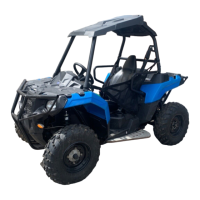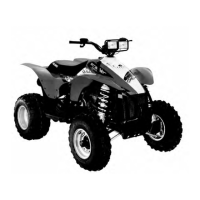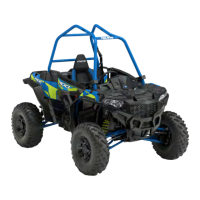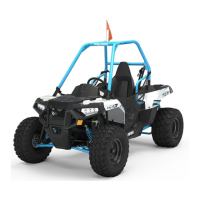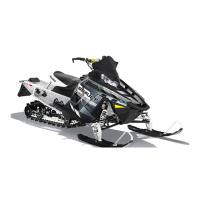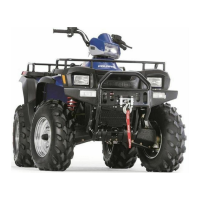GENERAL INFORMATION
2.31
BRAKE PAD INSPECTION
Pads should be changed when the friction material is
wornto3/64² (.1 cm), or about the thickness of a dime.
3/64²
(.1cm)
Minimum
Thickness
Hose/Fitting Inspection
Check brake system hoses and fittings for cracks,
deterioration, abrasion, and leaks. Tighten any loose
fittings and replace any worn or damaged parts.
WHEEL, HUB, AND SPINDLE
TORQUE T
ABLE
Item Specification
Front Wheel Nuts 35 Ft. Lbs. (47 Nm)
Rear Wheel Nuts 35 Ft. Lbs. (47 Nm)
Front Spindle Nut 40 Ft. Lbs. (55 Nm)
Rear & Center Hub Retain-
ing Nut
110 Ft. Lbs. (150 Nm)
WHEEL REMOVAL FRONT OR
REAR
Flange Nuts:
Flat side against wheel
1. Stop the engine, place the transmission in gear
and lock the parking brake.
2. Loosen the wheel nuts slightly.
3. Elevate the side of the vehicle by placing a
suitable stand under the footrest frame.
4. Remove the wheel nuts and remove the wheel.
WHEEL INSTALLATION
1. With the transmission in gear and the parking
brake locked, place the wheel in the correct
position on the wheel hub. Be sure the valve stem
is toward the outside and rotation arrows on the
tire point toward forward rotation.
2. Attach the wheel nuts and finger tighten them.
3. Lower the vehicle to the ground.
4. Securely tighten the wheel nuts to the proper
torque listed in the table above.
CAUTION:
If wheels are improperly installed it could affect
vehicle handling and tire wear . On vehicles with
tapered rear wheel nuts, make sure tapered end of nut
goes into taper on wheel.
